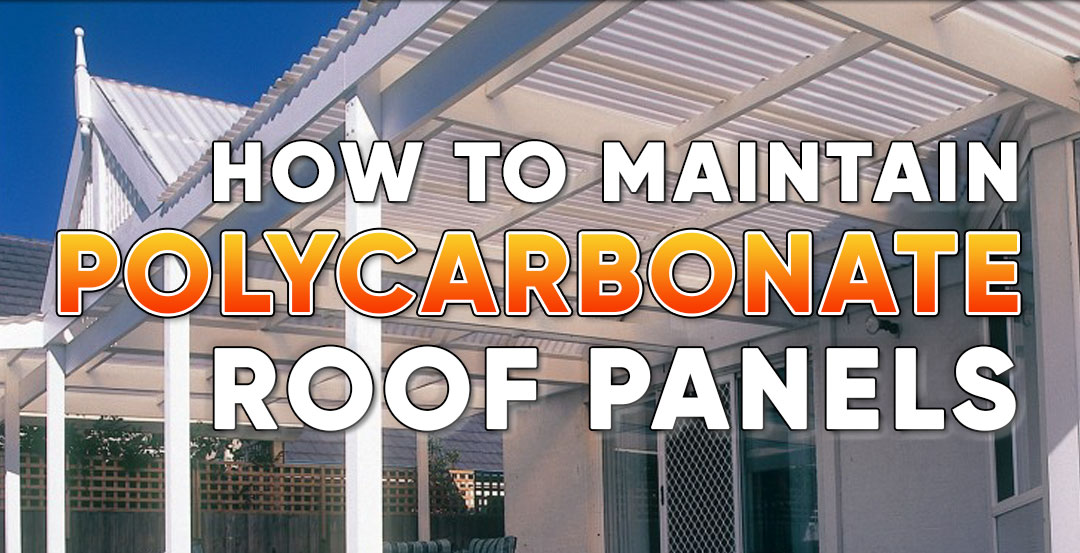
With summer just around the corner, there’s no better time to make sure your home is prepared and ready for any conditions. If you’re like the many smart Australians who own Polycarbonate roofing sheets, we’re here to provide all the DIY maintenance tips and tricks to keep your roofing in excellent condition.
Renowned for its durability and versatility, Polycarbonate roofing has quickly become one of the most popular choices for Australian homeowners. Made from polymer with high impact resistance, polycarbonate is a thermoplastic material available in a wide array of different sizes, styles and colours.
With UV protection, thermal insulation, and light transmission, these sheets are both lightweight and easy to install. However, while easy to install, keeping your roofing at peak performance involves a certain level of ongoing maintenance. Sometimes, a little extra cleaning goes a long way, and you’d be surprised how much of a difference it makes in the long run.
Whether you already own Polycarbonate or you’re about to use it for an upcoming renovation, this article will explain how to keep your roof panels in the best possible condition. From cleaning restoration and general DIY tips, we’ll get you up to speed with the major risk factors and methods to prevent future damage.
What Are Polycarbonate Roof Panels?
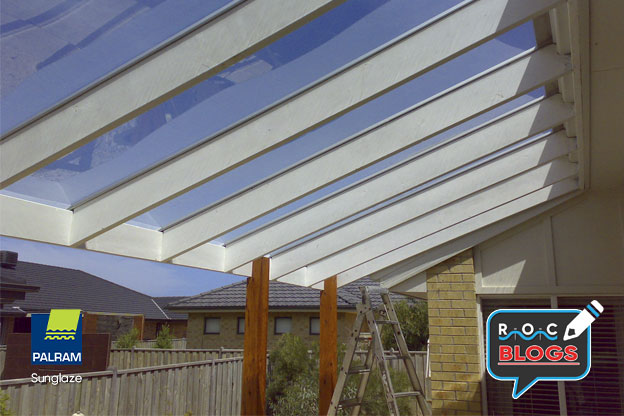
Polycarbonate roof panels are a clear, durable, and practical option for both builders and homeowners. Made from translucent plastic in several colours, sizes, and degrees of thickness, the material is specifically designed to counteract the effects of UV radiation. This means that it can easily handle temperature fluctuations and reduce heat penetration by up to 69%.
Being transparent, they naturally allow for natural vibrant light to enter outdoor spaces. Another benefit is the ability to choose from clear polycarbonate, corrugated sheets, or a wide range of multicoloured options. If you’re looking for softer lighting alternatives for your yard, Polycarbonate roof panels are also a beautiful option.
Although Polycarbonate panels are best used above outdoor decks and patios, they aren’t suited to the entire roof of a house. We will explore this in more detail a little later.
Why is Polycarbonate so Popular?
Cost-effective. Whether you’re planning for a big project or a smaller one for your patio or deck, Polycarbonate sheets are a great option if you’re on a budget.
Easy to handle. Being lightweight and flexible, Polycarbonate is easy for builders and roofers to use and install. Less delicate than glass, these panels are easily transported and can be cut down or reshaped without hassle.
More variety. Clear plastic isn’t your only choice in terms of style. With a number of opaque options that control the amount of sunlight coming into your yard, there are many colours and tints to suit your ideal design. If you want to give your backyard a refresh for the new season, this is one of the ways to do it.
Sun protection. With UV protective coating, Polycarbonate can keep areas in and around your home cool in summer and insulated during winter. Use Polycarbonate for temperature control of awnings, patios, or carports! Your roofing options are endless.
Durable. Polycarbonate sheets are fire resistant, can handle all types of weather, and can retain their colour for years.
What Can Damage Polycarbonate Roofing?
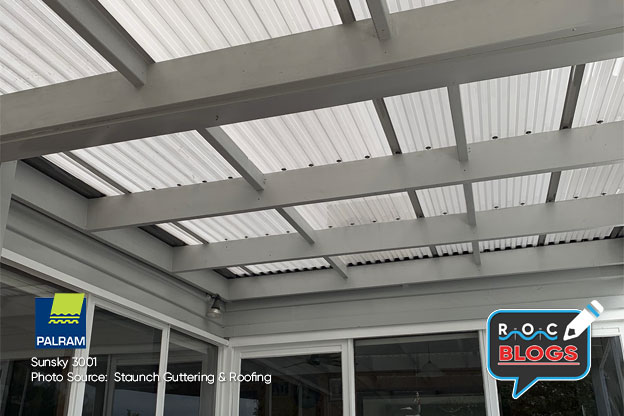
Although Polycarbonate is resilient by nature, there are ways it can be damaged by the environment. Understanding these risks and hazards helps you to prevent physical and visual damage. So, what can weaken Polycarbonate, and what can you do to prevent it?
Harsh Weather Conditions
Polycarbonate is tougher than fibreglass or plastic, but that doesn’t mean it’s invulnerable to harsh conditions. Wild weather, such as extreme hail or wind, can cause cracks, dents, or breakage. If you want to protect your roof sheeting from physical damage and weathering, we recommend using guards or shields when the forecast calls for extreme conditions.
UV Rays and Direct Sunlight
After prolonged exposure, ultraviolet radiation (UV) can cause Polycarbonate to yellow or discolour, ruining its look and quality. This is often the case with older structures that weren’t installed with the proper UV protection coating. If this is the case, the best course of action is to replace these panels with a new and more durable form of Polycarbonate.
As the home of roofing supplies in Melbourne, we have a great range of Polycarbonate products from leading brands and manufacturers. Explore our collection online or stop by your nearest ROC store today.
Chemical Substances
Polycarbonate is strong, but it isn’t immune to specific chemicals. Chemicals such as acetone, ethyl acetate, benzene, acetonitrile, carbon tetrachloride or tetralin are all substances that can compromise the quality of your Polycarbonate. Why? Exposure may lead to swelling, colour changes, structure modifications, or even stress cracks in the plastic that aren’t visible to the naked eye.
Different Types of Polycarbonate Sheet Roofing
With many Polycarbonate types to choose from, it can get overwhelming. So, what types of sheeting can you choose from, and what will suit your next project? For most roofing options for your home, cleaning with a soft sponge and warm soapy water does the trick.
- Polycarbonate Roofing Sheets. A common choice for sunrooms and patios, these clear roofing sheets have a protective layer for light transmission, reflecting UV rays from the sun. They’re available in many colours such as Clear, Opal, Cream, Bronze-tint, and Grey Tint.
- Suntuf EZ Glaze is known for excellent hail resistance. With a 3mm thickness sheeting and a glass-like appearance, this type of roofing can be installed directly onto rafters without needing purlins.
- Industrial Fibreglass Roofing is protected against yellowing while still maintaining translucency. With Gel Coat Technology, this roofing type can’t be split by impact or wild weather, resistant to water damage and UV damage.
- Ampelite Polycarbonate Roofing. As one of Australia’s top manufacturers, Ampelite is a premium-grade roofing option, manufacturing both Polycarbonate sheets and fibreglass.
Want advice on preserving your polycarbonate gazebos? Investing in the best roofing supplies across Dandenong, Langwarrin, and Berwick can provide you with the reassurance you need for quality and longevity.
Cleaning Your Polycarbonate Panels
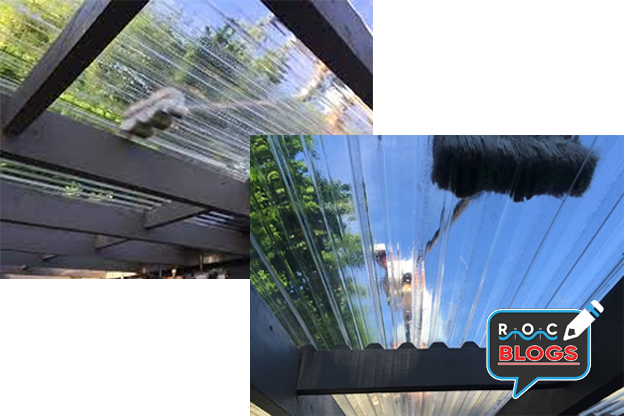
Do you have a Polycarbonate roof for your pergola? Polycarbonate has a life expectancy of 15 to 20 years, but over time, it may become cloudy and bring in less light. It’s recommended by roofing professionals to maintain and service your roof twice a year.
If you want your Polycarbonate sheeting to keep protecting your outdoor space, understanding the correct cleaning methods can extend its lifespan. As direct sunlight contributes to wear and discolouration, how can you protect your roof?
- Safety first. In many cases, you’ll need to access your roof to clean it, and you want to be doing this safely. Never walk directly on Polycarbonate sheets. They cannot support a person’s weight unless you provide an even load on top with a walk board or thick plywood. If you’re on the roof, make sure your base is resting over the screws. Placing a cloth sheet down beforehand will prevent any scratching.
Other options include extension poles, temporary wooden beams, ladders or crawl boards. Although polycarbonate is 200 times the strength of glass and can sustain impact, its flexibility can cause it to bend or dislodge if walked on, so do this with caution.
- Gather what you need. For the cleaning process, use soapy water and soft sponges, or a 100% cotton cloth as an alternative. The water should be lukewarm. Mild soaps or detergents are recommended as harsh chemicals such as high-alkaline products can scratch the polycarbonate. Never use abrasives, squeegees, or sharp objects as this can damage or scratch the protective coating.
- Remove debris. Whenever you’re cleaning a greenhouse or roof, all debris needs to be cleared from the plastic. Twigs, leaves, sediment, or deposits of dirt and mud should be removed to prevent the debris from damaging the polycarbonate. Next, rinse with lukewarm water. Quickly rinsing the plastic before you begin makes the cleaning process easier. All visible dirt will be washed away.
- Wash with water and soap. When using a chemical cleaner, don’t leave it on your sheets for long. After mixing your water and soap in a bucket, wash your Polycarbonate with a microfibre cloth or soft sponge. Your detergent should have no harsh chemicals such as white spirits. If you want a more thorough clean underneath, you can loosen the screw over the joins.
- Change your water/sponge often and rinse. Wash off all soap and rinse the Polycarbonate with water. If your sheeting hasn’t been washed in a while, it may need a second rinse.
- Dry the sheeting. You don’t want water streaks or spots, so drying the Polycarbonate with a soft cloth can help with a streak-free finish. It’s not recommended to wash your sheeting when it’s raining!
- Double-check your gutters. If you’re washing a polycarbonate roof, check your gutters for blockages to prevent any debris from building up.
Want to protect the roofing over your new porch or balcony? Invest in Polycarbonate roofing supplies across Frankston, Cranbourne, and Carrum Downs for your peace of mind.
Pressure Washing
You can pressure wash Polycarbonate, but it needs to be done correctly! Use a pressure washer with adjustable settings.
High pressures can damage the sheeting, so a gentle spray with warm water and mild soap can remove any stubborn debris or algae growth. Using a wide-angle spray nozzle can spread the water more evenly, reducing the risk of breaking the Polycarbonate.
Before pressure washing, always take off loose debris with a soft brush. This prevents tough particles from scratching the Polycarbonate. Direct the water flow at a downward angle, as a direct angle can shoot water under the seals or panels, resulting in leaking later on.
Are you keen to learn more about different types of roofing? Have a look at why to choose Colorbond guttering for your property.
Protect Your Polycarbonate Roofing Supplies in Melbourne
With the proper maintenance and care, Polycarbonate panels are an excellent long-term investment. Here at Roofing Options, you can speak directly to professionals who know how to keep your Polycarbonate materials in tip-top shape.
We not only supply and deliver a full range of Polycarbonate roofing supplies but also provide additional after-sales support to give you complete peace of mind moving forward. Contact us or stop by any of our Coburg, Campbellfield, and Cranbourne locations to view the entire collection up close.
